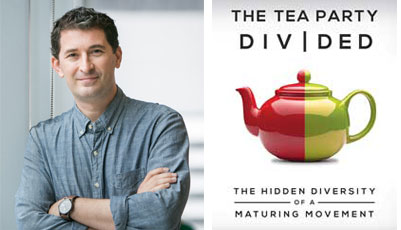
In his new book, The Tea Party Divided: The Hidden Diversity of a Maturing Movement (Praeger, 2015), Professor Heath Brown of John Jay’s Department of Public Management asserts that contrary to widely held opinion, the Tea Party is not a monolithic group of like-minded people, . Unlike previous works on the Tea Party, Brown examines the second phase of Tea Party growth to show that the party reflects a variety of different opinions.
Brown points out surprising divisions within the Tea Party as he explores the party’s evolution and examines important differences in terms of who has joined and who has served in Congress and other public offices. One of his key findings is that the Tea Party movement changed significantly from its first phase, which lasted from February 2009 to November 2010, to the second phase from December 2010 to November 2014. “I was impressed with the great scholarship on the early parts of the Tea Party movement, but there was little about the second phase,” said Brown, an Assistant Professor of Public Policy. “The organizations of the Tea Party became more formalized and institutionalized in Washington and I wanted to write a book that addressed this gap in the literature.”
Brown went on to note a second finding of his research, “that there were, and remain to some extent, cleavages between what different individuals in the Tea Party believed. There were Tea Party Republicans, Tea Party Libertarians, and even Tea Party Democrats, and each used this idea of a Tea Party revolution in slightly different ways.”
The book also focuses on the upcoming 2016 Presidential election and the overlap between the Tea Party members and Donald Trump supporters. “I think many of the current array of people affiliated with the Tea Party, particularly those who hold deeply xenophobic and anti-immigrant views, are very likely to support Trump,” said Brown. “This is different, in some ways, from the earliest days of the Tea Party where Trump's varied views on policy would have turned off many of those who cared mainly about overturning Obamacare, shrinking the size of the federal government, and were hostile to federal bailouts of corporations. The Tea Party has changed over time, and this would be reflected in who many Tea Party supporters would back in the election.”
The future relevance and influence of the Tea Party, Brown contends, will come down to the strategic direction taken by leaders and activists. “There are multiple trajectories for the Tea Party, one focused mainly on presidential politics,” he opined. “We see that in the campaigns of Ted Cruz and Marco Rubio, and even to some extent in Donald Trump. Another path forward could see an increasing focus on local-level issues, municipal and city politics, as opposed to grand national strategies.”
The Tea Party Divided: The Hidden Diversity of a Maturing Movement was named a “must-read book” for the week of Oct. 17 by the New York Post.
Brown hosts a podcast called New Books in Political Science, in which he interviews new authors about their political science publications. He is also an expert contributor to The Hill.



